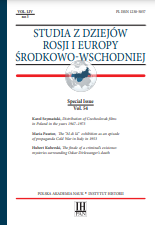The “Al di là” exhibition as an episode of propaganda Cold War in Italy in 1953
The “Al di là” exhibition as an episode of propaganda Cold War in Italy in 1953
Author(s): Maria PasztorSubject(s): Military history, Political history, Post-War period (1950 - 1989), Cold-War History
Published by: Instytut Historii im. Tadeusza Manteuffla Polskiej Akademii Nauk
Keywords: Cold War; Polish-Italian relations in the 1950s; Al di là; communism; cultural propaganda;
Summary/Abstract: At the height of the Cold War, cultural relations between the socialist states and the West became an important instrument of propaganda struggle within individual countries. On the Italian ground, exhibitions became an important instrument in the political struggle between the ruling Christian Democrats and the left (Italian Communist Party and Italian Socialist Party) as an element of visual propaganda. For the Christian Democrats in power, this role was to be played by a travelling exhibition entitled “On the other side [of the curtain]” (Mostra Al di là) depicting the lives of citizens of the states beyond the Iron Curtain. The display of poverty prevailing among vast sections of these societies, the terror and lack of democratic freedoms was intended to discourage the electorate from voting for left-wing parties in the upcoming parliamentary elections of 7 June 1953. Due to a strong position of the left (its strongholds being Central and Northern Italy), the exhibition was presented (in the days preceding the elections) in Piacenza and then in Turin, Ancona, Rome, Perugia and Terni. The detection of numerous hoaxes by the communist periodical L’Unità (the citizens of the oppressed countries presented at the exhibition actually being native Italians) caused not only a scandal but also a counteroffensive by the Communist Party, which not only revealed the fraud, but also launched a successful counter-campaign against the ruling camp. Although it would be an exaggeration to say the exhibition contributed to the poor election results of the Christian Democrats, the results of the elections of 7 June indeed did not meet their expectations. The coalition obtained 49.85% of the votes, which prevented it from benefiting of the “majority bonus” and gaining an absolute majority in the Chamber of Deputies. The communists achieved a significant success with 22.6% of the votes (an improvement on the 1946 result), as did the monarchists and neo-fascists.
Journal: Studia z Dziejów Rosji i Europy Środkowo-Wschodniej
- Issue Year: 54/2019
- Issue No: Sp.
- Page Range: 205-224
- Page Count: 20
- Language: English

